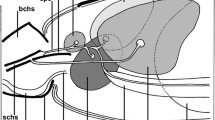Abstract
The tegument ofCorrigia vitta has been examined systematically by scanning and transmission electron microscopy. Its basic structure is of typical platyhelminth plan but there are several features of surface morphology which distinguish the worm. The tegument is microvillous and in the anterior dorsal region bears numerous small protuberances with a fine fibrous content. Non-ciliated sensory papillae, containing a bulbous nerve ending and covered by tegument, occur in distinct annular patterns on the suckers. An infolding of body tegument lines the foregut and is confluent with the gastrodermis. The transition region is characterised by the elevation of tegumental nuclei to the surface syncytium, and by the appearance of an organized granular endoplasmic reticulum and Golgi elements in the cytoplasm. There is also a gradual disappearance of tegumental secretory bodies which is coincident with a reduction in the amount of surface glycocalyx. Tegumental mitochondria vary in size and number and show a distinct regional distribution. Ventral tegument mitochondria are numerous, with many cristae, and stain strongly for cytochrome oxidase; those in the dorsal tegument and foregut have few cristae and stain only moderately for the enzyme. Results are discussed with respect to surface function and the close association of ventral tegument with pancreatic duct epithelium.
Similar content being viewed by others
References
Allison FR (1980) Sensory receptors of the rosette organ ofGyrocotyle rugosa. Int J Parasitol 10:341–353
Bryant C, Behm CA (1976) Regulation of respiratory metabolism inMoniezia expansa under aerobic and anaerobic conditions. In: Biochemistry of Parasites and Host-Parasite Relationships, Van den Bossche H (ed). Elsevier/North-Holland Biomedical Press, Amsterdam, pp 89–94
Crompton DWT, Joyner SM (1980) Parasitic worms. Wykeham Publications (London) Ltd
Erasmus DA (1977) The host-parasite interface of trematodes. In: Advances in Parasitology, Dawes B (ed). Academic Press, London and New York, 15:201–242
Ernst SC (1975) Biochemical and cytochemical studies of digestive-absorptive functions of esophagus, cecum and tegument inSchistosoma mansoni: acid phosphatase and tracer studies. J Parasitol 61:633–647
Graham RC, Karnowski MJ (1965) The early stages of absorption of injected horseradish peroxidase in the proximal renal tubules of mouse kidney: ultrastructural cytochemistry by a new technique. J Histochem Cytochem 14:291–302
Halton DW (1979) The surface topography of a monogenean,Diclidophora merlangi revealed by scanning electron microscopy. Z Parasitenkd 61:1–12
Halton DW (1982a) Morphology and ultrastructure of parasitic helminths. In: Parasites — Their World and Ours. Mettrick DF, Desser SS (eds). Elsevier Biomedical Press, Amsterdam, pp 60–69
Halton DW (1982b) An unusual structural organization to the gut of a digenetic trematode,Fellodistomum fellis. Parasitology 85:53–60
Hamajima F, Fujino T, Yamagami K, Fukuda K (1982) Mitochondria in the body wall of life cycle stages of lung flukes of the genusParagonimus, and mitochondrial cytochrome components of the adult worm. Comp Biochem Physiol (A) 71:149–156
Hanna REB (1980a)Fasciola hepatica: glycocalyx replacement in the juvenile as a possible mechanism for protection against host immunity. Exp Parasitol 50:103–114
Hanna REB (1980b)Fasciola hepatica: an immunofluorescent study of antigenic changes in the tegument during development in the rat and sheep. Exp Parasitol 50:155–170
Hoole D, Mitchell JB (1981) Ultrastructural observations on the sensory papillae of juvenile and adultGorgoderina vitelliloba (Trematoda: Gorgoderidae). Int J Parasitol 11:411–417
Lumsden RD (1975) Surface ultrastructure and cytochemistry of parasitic helminths. Expl Parasitol 37:267–339
Ogbe MG (1982) Scanning electron microscopy of the tegumental surfaces of adult and developingSchistosoma margrebowiei Le Roux, 1933. Int J Parasitol 12:191–198
Panin VJ (1978) The ultrastructure of the tegument of the trematodeCorrigia corrigia (Braun 1901). IV International Congress of Parasitology Warsaw Section B Short Communications p 17 (In Russian)
Pappas PW, Read CP (1975) Membrane transport in helminth parasites: a review. Exp Parasitol 37:469–530
Žďárská Z (1977) Scanning electron microscopy of the cercaria ofDicrocoelium lanceatum. Folio Parasitol (Praha) 24:265–267
Author information
Authors and Affiliations
Rights and permissions
About this article
Cite this article
Robinson, R.D., Halton, D.W. Functional morphology of the tegument ofCorrigia vitta (Trematoda: Dicrocoeliidae). Z. Parasitenkd. 69, 319–333 (1983). https://doi.org/10.1007/BF00927874
Accepted:
Issue Date:
DOI: https://doi.org/10.1007/BF00927874




